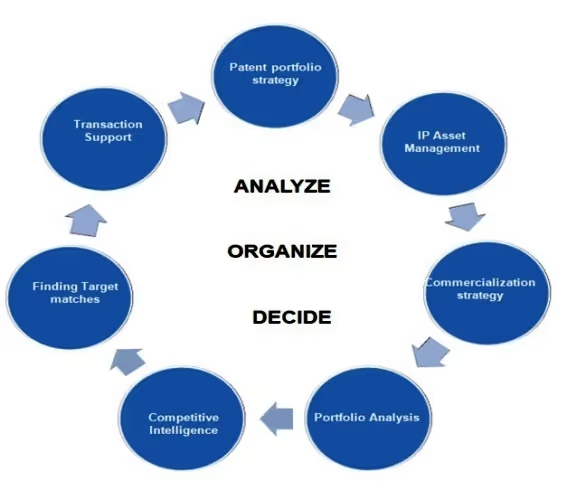
Top 10 Knowledge Management Platforms for R&D Teams in 2025


Research and innovation teams understand the importance of Intellectual Property (IP) portfolio analysis in order to protect their investments. An IP portfolio is a collection of all registered trademarks, copyrights, patents, trade secrets, and other forms of intellectual property associated with an organization or individual. Conducting an IP portfolio analysis can help organizations identify potential opportunities for improvement as well as areas where they may be vulnerable to litigation.In this blog post, we will explore what IP portfolio analysis entails, how it should be conducted effectively, common challenges, and strategies to optimize your IP portfolio.Join us on our journey to understanding the ins and outs of effective IP portfolio analysis!
Table of Contents
What is IP Portfolio Analysis?
Benefits of IP Portfolio Analysis
How to Conduct an IP Portfolio Analysis
Common Challenges in IP Portfolio Analysis
Identifying the Right Metrics and KPIs
Analyzing Data Accurately and Efficiently
Strategies to Optimize Your IP Portfolio
IP portfolio analysis is the process of analyzing a company’s intellectual property assets to gain insights into how best to manage and protect them. It involves assessing the value, strength, and potential risks associated with each asset in order to develop an effective strategy for protecting it. The goal of IP portfolio analysis is to help companies maximize their return on investment by ensuring that they are leveraging their intellectual property assets in the most efficient way possible.
The primary benefit of conducting an IP portfolio analysis is that it provides organizations with valuable information about their existing patent portfolios.For example, IP portfolio analysis allows you to understand which patents are strong enough to warrant further investment or licensing agreements and which ones may need additional research or development before they become commercially viable.Additionally, this type of analysis also helps companies identify areas where they may have overlooked important aspects when developing new products or services – allowing them to better prepare themselves against competitors who may try to infringe upon their rights.Ultimately, all types of IP portfolio analysis aim to provide organizations with actionable intelligence so that they can make informed decisions regarding how best to protect their intellectual property rights while maximizing ROI.
Key Takeaway: IP portfolio analysis is a systematic evaluation of an organization’s intellectual property assets to identify opportunities for improvement or protection.
Conducting an IP portfolio analysis is a critical step for any research and development (R&D) or innovation team. It helps teams identify gaps in their intellectual property (IP) assets, evaluate the performance of existing IP, and make informed decisions about future investments.Here’s how to conduct an effective IP portfolio analysis.The first step is to identify all relevant data sources related to your organization’s current and potential intellectual property assets. This includes patents, trademarks, copyrights, trade secrets, etc.Once you have identified the data sources that are applicable to your organization’s goals and objectives, you can begin gathering information from them. This may include collecting patent applications or searching databases such as Google Patents or USPTO records for existing patents related to your industry or product lines.Additionally, it may be beneficial to review competitor portfolios and compare them with yours in order to gain insights into what other organizations are doing within the same space.There are numerous tools available that can help streamline the process of analyzing large amounts of data associated with intellectual property portfolios. Cypris is one such platform designed specifically for R&D teams, providing rapid time-to-insights by centralizing multiple data sources into one platform.Here are other resources you may find online:
When conducting an effective IP portfolio analysis, it is important to not only gather accurate data but also interpret it correctly. To ensure accuracy during this process, it is important to consider both quantitative factors (number of filings/grants) along with qualitative ones (quality/strength of claims).It may also be beneficial to use visualization techniques – e.g., heat maps – to quickly spot patterns within large datasets.Finally, remember to stay up-to-date on changes in market dynamics and the technology landscape, as these often affect the value of certain types of intellectual property assets.Next, we’ll explore some common challenges in IP portfolio analysis.
Key Takeaway: Conducting an IP portfolio analysis can help you make informed decisions about your innovation and R&D strategies. To ensure a successful analysis, it is important to identify the right metrics and KPIs for evaluation, analyze data accurately and efficiently, and keep track of changes in the market.
Conducting an effective IP portfolio analysis can be challenging due to several factors.
One of the biggest challenges in IP portfolio analysis is determining which metrics and key performance indicators (KPIs) are most relevant for evaluating intellectual property assets. Different industries have different needs when it comes to analyzing their portfolios, so it’s important to consider industry-specific trends when selecting metrics and KPIs.
Another challenge associated with IP portfolio analysis is accurately analyzing data from multiple sources in order to draw meaningful conclusions about a company’s intellectual property assets. This requires collecting data from various sources such as patents databases, technology roadmaps, competitor analyses, etc., then combining them into one comprehensive report that can be used by decision-makers within the organization.To do this efficiently requires having access to powerful tools that allow users to quickly search through large amounts of data and generate actionable insights quickly.Analyzing an IP portfolio can be a complex and time-consuming process, but with the right strategies in place, it can be made much more efficient. Let’s explore how to optimize your IP portfolio by leveraging technology and automation.

(Source)
Developing a comprehensive strategy for your intellectual property assets is essential to ensuring that you are able to protect them effectively. This includes identifying the types of IP that you own, understanding how they can be used, and creating a plan for protecting them. It also involves evaluating the competitive landscape and staying up-to-date with market trends so that you can make informed decisions about when to invest in new technologies or expand existing ones.Additionally, it’s important to have an understanding of the legal implications associated with each type of IP asset so that you can ensure compliance with applicable laws.Leveraging technology to streamline processes related to managing your intellectual property assets is another key component of optimizing your portfolio. By using tools such as the Cypris research platform, R&D teams can quickly access data sources needed for analyzing their portfolios.Automation capabilities within these platforms enable teams to set up alerts when changes occur in their portfolios or competitor landscapes, allowing them to stay ahead of potential risks or opportunities.
Key Takeaway: Technology tools like Cypris can help streamline processes related to portfolio management by providing access to data sources needed for analysis. Automation capabilities within these platforms also allow teams to set up alerts when changes occur in their portfolios or competitor landscapes so that they can stay ahead of potential risks or opportunities.
IP portfolio analysis helps teams identify potential opportunities for growth and better understand the competitive landscape. By understanding their current IP portfolio, teams can develop strategies to optimize it for maximum value. With the right tools in place, teams can quickly analyze their IP portfolios to make informed decisions about future investments.Are you looking for an efficient way to analyze your intellectual property portfolio? Cypris is the perfect solution! With our research platform, R&D and innovation teams can quickly access all of their data sources in one place.We provide fast time-to-insights that will help you make informed decisions about your IP investments faster than ever before. Get started with us today and start making smarter decisions now!